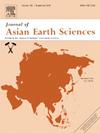Constraints of detrital garnet and zircon on provenance of Late Permian–Early Triassic fore-arc sedimentary succession in the Kurosegawa Belt, Japan
IF 2.7
3区 地球科学
Q2 GEOSCIENCES, MULTIDISCIPLINARY
引用次数: 0
Abstract
The ages of detrital zircons are not always sufficient to definitively constrain sediment sources. Information obtained from the ages of these zircons should be complemented with information from other detrital minerals such as garnet. However, studies using detrital garnets and zircons regarding provenance shift are rare. In this study, we elucidate the effectiveness of a method combining detrital garnet and zircon analyses from the Late Permian–Early Triassic Shingai Unit of Southwest Japan and reveal spatial changes in the Permian–Triassic provenance of fore-arc sedimentary successions in Japan. A comprehensive analysis showed that the detrital garnets changed from almandine- to grandite-dominated assemblages, implying a provenance shift from non-calcareous to calcareous metamorphic rocks. Conversely, detrital zircons consistently indicate a predominantly igneous origin, comprising Late Paleozoic–Early Mesozoic ages with minor pre-Late Paleozoic ages. The statistical results of the detrital garnet compositions and zircon ages showed different characteristics, and the variation in garnet composition indicated a shift in metamorphic origin. Conversely, the variation in the zircon spectra may be influenced by different proportions of pre-Late Paleozoic components of igneous origin. These findings highlight that the detrital zircon record influenced predominantly by igneous sources, whereas the detrital garnet record is primarily influenced by metamorphic sources. Based on regional geological information, the primary provenance of the Permian–Triassic fore-arc successions in Japan is a Late Paleozoic–Early Mesozoic volcanic arc with contact metamorphic rocks and pre-Late Paleozoic arc-related rocks, which changed from volcanic and non-calcareous metamorphic rocks to plutonic and calcareous metamorphic rocks through uplift and denudation.
求助全文
约1分钟内获得全文
求助全文
来源期刊

Journal of Asian Earth Sciences
地学-地球科学综合
CiteScore
5.90
自引率
10.00%
发文量
324
审稿时长
71 days
期刊介绍:
Journal of Asian Earth Sciences has an open access mirror journal Journal of Asian Earth Sciences: X, sharing the same aims and scope, editorial team, submission system and rigorous peer review.
The Journal of Asian Earth Sciences is an international interdisciplinary journal devoted to all aspects of research related to the solid Earth Sciences of Asia. The Journal publishes high quality, peer-reviewed scientific papers on the regional geology, tectonics, geochemistry and geophysics of Asia. It will be devoted primarily to research papers but short communications relating to new developments of broad interest, reviews and book reviews will also be included. Papers must have international appeal and should present work of more than local significance.
The scope includes deep processes of the Asian continent and its adjacent oceans; seismology and earthquakes; orogeny, magmatism, metamorphism and volcanism; growth, deformation and destruction of the Asian crust; crust-mantle interaction; evolution of life (early life, biostratigraphy, biogeography and mass-extinction); fluids, fluxes and reservoirs of mineral and energy resources; surface processes (weathering, erosion, transport and deposition of sediments) and resulting geomorphology; and the response of the Earth to global climate change as viewed within the Asian continent and surrounding oceans.
 求助内容:
求助内容: 应助结果提醒方式:
应助结果提醒方式:


